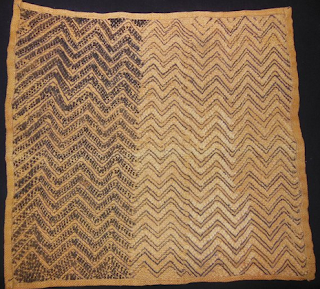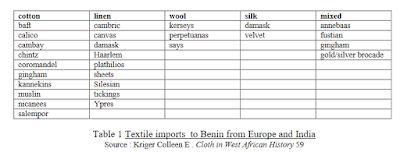Sunday, September 9, 2018
Pagne Kuba
In sub-Saharan Africa, where representative art has flourished for centuries, carvers and crafts people have typically taken for their subjects human figures, animals, plants, and elements of the natural world. Abstract art, meanwhile, has remained marginal. The textiles of the BaKuba (Kuba) people of the Democratic Republic of Congo are an exception. Although part of a tradition that stretches back 400 years, Kuba textiles have a strikingly modern look. They use improvised systems of signs, lines, colors, and textures, often in the form of complex geometric rectilinear patterns. Their appliqués are reminiscent of works by 19th- and 20th-century masters like Matisse, Picasso, Klee, Penck, and Chellida. This is no coincidence: all of those artists were inspired by Kuba design!"
"The most commonly known of the Kuba textiles are the cut-pile Shoowa or Kasai Velvets, named after the river along which the BaKuba live. Improvisation and irregularity characterize the Kasai Velvets. This is because the weaver works without a plan or preliminary sketching, though the model can occasionally be displayed on the cloth in advance using black thread. Often the design is built up from memory, repeating the most common designs and color combinations found in the region. The message conveyed is up to the artist, who is the only one who can explain what he or she intended to represent."
"Originally Kasai Velvets were used as currency, and were valuable products for trade and exchange. They could be included in the tribute villagers paid annually to the King, in the dowries of matrimonial exchanges, and in funeral gifts and offerings to the dead. They also served to embellish the royal court, cover the royal thrones, and decorate the King’s palace wall. Colonial agents and missionaries arriving in the Kuba Kingdom in the nineteenth century were fascinated by the Kasai Velvets, and encouraged women to produce more of them to adorn religious vestments for Catholic missionaries and decorate the interiors of European houses." This piece measures 18" x 20"
Friday, September 7, 2018
The Dress of Makoti
This is an example of the dress of makoti. To show respect and submission to the authority of her husband and parents-in-law, traditional practice dictated that a newly-married Xhosa woman would wear her ikhetshemiya (headcloth) low over her forehead, keep her shoulders covered, cover her hips with a blanket and wear a isishweshwe skirt and apron. She should stay with her parents-in-law for up to a year, a period during which her behaviour conveyed that she adhered to ukuhlonipha traditions of respect. Aspects of this practice are still present but are being eroded with urbanization. Head cloth, blanket and towel on loan from Siphokazi Mesele, nee Lindelwa Pamela Mbola, who wore them when she was makoti.
Blaudruck
Simplified resist-dyeing techniques were used to create a fabric of
small, white, regularly spaced patterns on a deep blue background. This
was known in Germany as 'blaudruck' (blue print). This fabric was
transformed into garments for work-wear and peasant-wear, and became
associated with European regional and Protestant dress, as well as
expressing nationalist sentiments. When German missionaries and traders
immigrated to the Eastern Cape and other parts of southern Africa during
the mid-1800s, they brought their 'blaudruck' with them and traded with
those they came in contact with. It became popular amongst women on
mission stations. This fabric was later adopted by IsiXhosa women in the
Eastern Cape to produce garments.
Indienne
One of the oldest artefacts in the isishweshwe collection, this dress is
an example of 'Indienne'. It is made of Indian cotton (chintz or
calico) and has a continuous pattern of delicate intertwined stems
bearing leaves and flowers. The dress originated on the Coromandel coast
of India in the third quarter of the 18th century. Indian chintz was
extremely popular throughout the eighteenth century, and was imported
into the Netherlands by the Dutch East India Company, thus making it
available at the Company's halfway station at the Cape.
IsiShweshwe and Colonialism
The
cloth known as amajamane, amajerimane or isishweshwe has its origins in
the East, and was originally made from cotton and blue dye from the
indigo plant. Through trade, it spread to different parts of the world
including the Cape, where it was initially worn by slaves, Khoisan and
colonialists. The earliest origins of isishweshwe can be traced back to
the craze for colourful indiennes (Indian cottons) which spread like
wildfire across Europe from the mid-1600s. The complicated techniques
for making multi-coloured indiennes in Central Europe were eventually
adapted to the use of one colour only: indigo.
Thursday, September 6, 2018
Wednesday, September 5, 2018
Raffia
Possibly Teke artist
Raffia cloth
(nkuta)
Date: Early 20th century
Medium: Raffia
Dimensions: H x W: 33.2 x 28.3 cm (13 1/16 x 11 1/8 in.)
Credit Line: Gift of S. M. Harris
Geography: Lower Congo-Kasai River region, Democratic Republic of the Congo
Object Number: 99-13-47
Search Terms:
Funerary
Trade
Object is not currently on exhibit
Woven
goods, such as cloth strips and fiber mats, were used in parts of
Africa as currency. Parties of the transaction used variations in width
and the quality of the weave as a means to negotiate value. Cloth was
also frequently used in connection with other currencies, such as brass
rods, thus lending additional leverage to the negotiation. Cloth or mats
of more or less uniform size were used for gifts, peace offerings,
payment from a son to his father upon attaining adulthood and payment
upon the birth of a child or the burial of a parent. Cloth currency was
also used as a tribute for a spouse who remained faithful or, by
contrast, as a penalty for adultery. In central Africa raffia woven
mats, stored flat or rolled into bundles, were a popular form of cloth
currency in the late 19th and early 20th century. Among the Teke
peoples, funerals of the wealthy and nobility required raffia cloths not
merely to cover the body but in abundance to ensure a proper status in
the "village of the dead."
Cloths with Names’: Luxury Textile Imports in Eastern Africa, c. 1800–1885
In the nineteenth century, a vast area of eastern Africa stretching the
length of the coast and into the reaches of the Congo River was
connected by long-distance trade mostly channelled through the Omani
commercial empire based in Zanzibar. As studies have recently shown, a
critical factor driving trade in this zone was local demand for foreign
cloth; from the 1830s the majority of it was industrially made coarse
cotton sheeting from Europe and America, which largely displaced the
handwoven Indian originals. Employing archival, object, image and field
research, this article demonstrates that until 1885 luxury textiles were
as important to economic and social life in central eastern Africa,
textiles known to the Swahili as ‘cloths with names’. It identifies the
thirty or so varieties which élites — and, increasingly, the general
population — selected for status dress and gifts, instrumental in
building the commercial and socio-political networks that linked the
great region. Finally, it shows that the production and procurement of
most varieties remained in the hands of Asian textile artisans and
merchants; most prestigious and costly were striped cotton and silk
textiles handcrafted in western India, and in the southern Arabian
nation of Oman. European industrial attempts to imitate them were
hampered by several factors, including their inability to recreate the
physical features that defined luxury fabrics in this region — costly
materials, rich colours, complex designs and handwoven structures.
"Gabon" Textile
"Gabon" Textile
- Designer:
- Nathalie du Pasquier (French, born Bordeaux, 1957)
- Manufacturer:
- Rainbow, Milan
- Date:
- 1982
- Medium:
- Cotton
- Dimensions:
- 55 in. × 13 ft. 3 in. (139.7 × 403.9 cm)
- Classification:
- Textiles-Painted and Printed
- Credit Line:
- Gift of Geoffrey N. Bradfield, 1986
- Accession Number:
- 1986.398.3
- Nathalie du Pasquier was a founding member of Memphis. Barbara Radice, Sottsass’s partner, describes her as "a kind of natural decorative genius—anarchic, highly sensitive, wild, abstruse, capable of turning out extraordinary drawings at the frantic pace of a computer. . . . [Her works] are enthusiastic, explosive, exalted, elated, as striking as neon in a tropical night." Du Pasquier’s complex repeating patterns embrace all manner of influences, including African textiles, Cubism, Futurism, Art Deco, and graffiti. This work belongs to a series based on African patterns. Other designs are titled Kenya, Zaire, and Zambia.
Tuesday, September 4, 2018
Jadis
chaque
tribu
était
plus
ou
moins
spécialisée
dans
tel
ou
tel
artisanat;
les
Baduma
et
les
Mitsogo
excellaient
dans
la
confection
de
tissus
de
raphia
(ibongo),
les
Ngowè
dans
le
tissage
des
nattes
fines
à franges
(tava
yi
N gowe)
,
les
Batsangui
dans
le
travail
du
fer
(imyanga).
Ainsi,
jusqu'à
ces
derniers
temps,
les
Adyumba
étaient
renommés
comme
fabriquants
de
poterie
(ambono).
Sunday, September 2, 2018
Saturday, September 1, 2018
Subscribe to:
Comments (Atom)



















